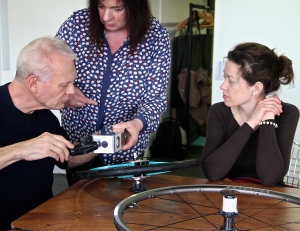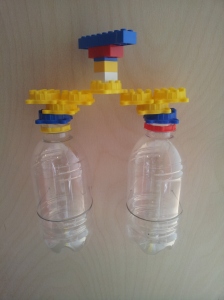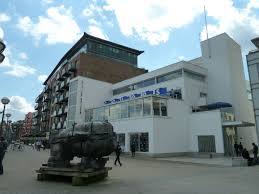Somerset House Access
A New Programme for visually impaired visitors
An Introductory Tour of Somerset House with a Focus Group
Date: 1 June 2019

Image: The Edmond J. Safra fountain court, Somerset House, with the North Wing in the background.
Image description: This is on the approach to the fountain quadrangle from the Seamen’s Hall, with the fountain in the foreground and the North Wing in the background. It is a bright sunny day with the blue sky visible above the North Wing. A young girl in a bright red t-shirt can be seen on the left playing with the fountain.
This Pilot session with a Focus Group explored the possibilities and opportunities available to visually impaired and differently-abled visitors to this contemporary arts centre in the heart of London.

Image: The Old Somerset House and the Thames. Circa 1680 | Image credit: Somerset House.
Image description: The Old Somerset House is in the background and the Thames in the foreground, with several boats sailing past the Embankment entrance.
Somerset House
Somerset House is a contemporary arts centre in the heart of London offering a diverse and dynamic public programme to a large community of creative businesses, artists and makers. It is also one of London’s most spectacular and well-loved spaces where art and culture is imagined, made and experienced by over 3 million visitors every year.
The Introductory Tour
This Introductory tour, created to explore the possibilities and opportunities within Somerset House, was devised around three elements; the History, the Architecture, and the current use of the building. The tour took us from the Seamen’s Hall to the Stamp stairs, the Embankment entrance, the Edmond J. Safra fountain court, the North Wing archway and finished in front of the statue of King George III. The feedback session was moderated by Lynn Cox, a VI artist and facilitator.
Starting at the Seamen’s Hall, a space full of character and offering a sense of grandeur with its white marble floors, imposing Corinthian columns, chandeliers and huge windows, we went on to view the architectural facade at the bottom of the Stamp stairs, which is on the street level from the Embankment entrance.
A Focus Group was invited to test the resources and give their objective evaluation. A key goal for this pilot session is to develop a programme that will become a valid cultural learning experience.

Image: VI visitors viewing the architectural facade of the North Wing.
Image description: Standing at the base of the Stamp stairs, VI visitors stand in front of the facade of the North Wing. The white facade is set on a two foot plus tall dark grey plinth, installed on the right side of the room. Three VI’s and a sighted guide discuss the features of the facade.
At the base of the Stamp stairs is the installed architectural facade of the North Wing. This facade, the exterior wall or face of a building, features detailed characteristics of the architecture of the building. Facades usually involve design elements like deliberate placement of windows or doors and the elaborate features and decorations in the structure. The North Wing facade reveals the massive arched doorways, large porch and wide windows, and plenty of consideration into the types of fenestrations used including the wall panels and curtain walls.

Image: VI visitors by the Embankment entrance listening to a detailed history of Somerset House.
Image description: Standing just under the arch at the Embankment entrance, four VI visitors and two sighted guides stand together to discuss the historical information about the building.
Leading out northbound from the Seamen’s Hall to the Edmond J. Safra fountain court, we view the courtyard which is one of the grandest locations in London. It is centred around Somerset House’s iconic fountains and surrounded on all sides by 19th century buildings.
This Grade 1 listed building does have some physical access limitations because of steps from the Seamen’s Hall and narrow walkways, uneven surface of the Stamp stairs and a cobbled square that goes all the way around the fountain and leading up to the North Wing.
To help with the interpretation of the space, we made reference to the architectural facade displayed in the Stamp stairs and used a 3D model of the top of the Corinthian columns. The Corinthian column is very ornate with slender fluted columns, with elaborate capitals decorated with leaves and rings.
Somerset House Today
Somerset House is a cultural destination with residents including over 100 organisations from the arts and creative industries. The Somerset House Exchange provides a co-working space for 120 small businesses and start-ups, including Makerversity, a pioneering collection of emerging maker businesses supported since its launch.
Since 1775 when a new building was erected, designed by William Chambers, the building housed various government departments including births, marriage, deaths and the Inland Revenue.
Somerset House was established in July 1997 to conserve and preserve Somerset House as an arts centre. After a campaign to open Somerset House to the public, it became a home for arts and culture in 2000.
Future Tours
The Somerset House Learning and Skills team and the MaMoMi team are reviewing some exciting possibilities and are keen to make this programme a valid learning experience for differently-abled visitors. Updates will be posted shortly.
Accessibility
Somerset House strives to be open and accessible to all, and continue to work to remove barriers for visitors with disabilities and to ensure our event and exhibitions are accessible.
To discuss your visit, call 0207 845 4600 to speak to someone in visitor experience between 10.00 and 17.00. You can also email visitor@somersethouse.org.uk and someone will get back to you as soon as possible. You can also contact us at MaMoMi via info@mamomiinitiative.com
Address
Somerset House, Strand, London WC2R 1LA
Getting here
The underground from Temple Station to Embankment entrance, which is approximately 200m. You can also use the main line stations Charring Cross, Blackfriars and Waterloo.
Credits
Andrew Mashigo: Tour Developer and Facilitator
Lynn Cox: Tour Developer and Facilitator
Catherine-Ritman Smith: Head of learning and Skills, Somerset House
Sophia-Hinton Lever: Learning and Skills Coordinator, Somerset House
Stu Baker: 3D Model Designer
Image credit: Somerset House Trust and MaMoMi
Large Print guide and Braille: MaMoMi initiative
#somersethouse #access #visual #arts #culture #education #mamomi
























